
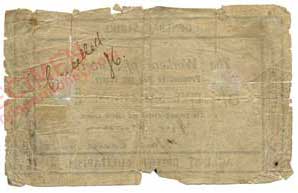
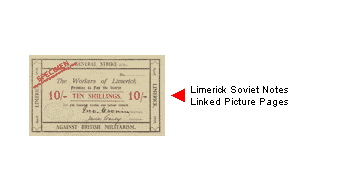
This page is under active revision: Revision to reflect new research and newly discovered examples of notes. Addition of detailed references, with urls where available. Latest information is on the LSNC discussion board.
Last revision: 10.12.23.
A general strike in Limerick in 1919 lead to the creation of a small issue of 'Strike Treasury Notes' in April 1919. These are known as the Limerick Soviet Notes.
The general strike in Limerick in 1919 during the Irish war of independence was in response to the British declaration on 9 April 1919 of much of Limerick City as a special military area (SMA), a proclamation that would take effect on Monday 14 April [1. Cahill 1990, p. 60-62]. The general strike started on 14 April 1919 [14. ILPTUC Report 1919, P. 56]
The general strike quickly became known as the Limerick Soviet, though it was not a true 'soviet' as the seizure of private property by the strike organisers was quickly abandoned when faced with resistance by the coal merchants [Cahill 1990, p. 144].
The strike lasted two weeks, with the organising strike committee issuing a resolution for a return to work on Monday 28 April [8. Irish Times 2019].
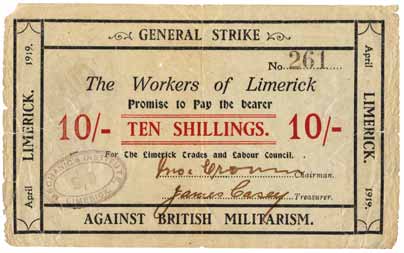
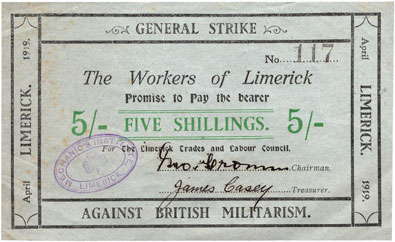

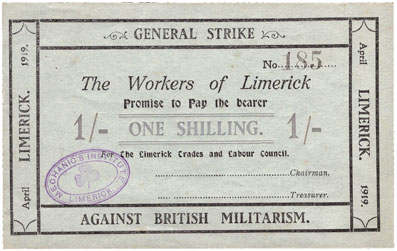

Some unions, most notably the National Union of Railwaymen, decided not to issue strike pay to their members taking part in this Limerick general strike. And although food was sent in sizable quantities from the outside, little money was forthcoming. The resulting shortage of money in circulation lead the strike committee to take the decision to create its own currency in the form of 'treasury notes' in the second week of the strike [Cahill 1990, p. 74-76].
The notes were to be issued in support of 'General Strike Against British Militarism' in the name of 'The Workers of Limerick' with a 'Promise to pay the bearer' the amount denominated 'for the Limerick Trades and Labour Council'. Limerick April 1919.
The strike committee decided on the production of paper money tokens in three denominations, 1 Shilling, 5 Shillings, and 10 Shillings, for use inside the martial law zone to compensate for a lack of incoming funding [Cahill 1990, p. 74-76]. This would leave a week for the notes to be printed, authenticated by numbering, stamping and signing, and issued before the end of the strike on 28 April.
The 21 April edition of the daily paper of the strike committee, the Workers Bulletin announced that "The workers council has issued its own currency notes in 1 Shilling, 5 Shilling, 10 Shilling issues, which will be circulated this evening, and same will be duly redeemed."
News of the production of the 'Strike Treasury Notes' was reported in the international press on 22 April [11. Toronto World, 1919; 12, South Bend News-Times, Indiana, 1919]. These Limerick Soviet Notes were said to have briefly circulated, with all notes presented being redeemed after the end of the issue [Cahill 1990, p. 75]. Other unspecified references indicate that these 'Treasury Notes' may in fact actually not have entered circulation [7. O'Connor Lysaght 1979]. Which of these is correct has yet to be determined.
This currency issue is a unique event in the history of Irish paper money.
Security for the note issue was initially to be the food stocks sent free from outside and the financial support of the workers of Limerick, and later the notes were backed by the trades council and the Trade Union Congress, and by the approved shops which agreed to accept them [Cahill 1990, p. 75]. The banknote issue proved to be a stable one.
A sub-committee of the LTLC propaganda committee was in charge of printing and issuing the currency. The size of the population would suggest the need for a substantial banknote issue. Available data suggests that the entire issue was redeemed by the LTLC. A small surplus of unredeemed banknotes remained in a fund that had been subscribed to by sympathisers throughout Ireland [Cahill 1990, p. 77]. Some of these notes were probably kept as souvenirs.
Other souvenirs may have been retained from unissued stocks of the notes, and it is these notes which might be those that lack some of the validation marks, such as numbers, correct signatures, or the Mechanic's Institute stamp.
The Limerick Soviet notes were produced in three denominations, One Shilling, Five Shillings, and Ten Shillings.
Dimensions of Limerick Soviet notes are 140 x 86 mm for all denominations.
Underprint colour varies by denomination: One Shilling, grey; Five Shilling, green; Ten Shilling, red.
Kemmy [3. 1976] states that ‘thousands of pounds’ were issued. However, currency notes have not been seen numbered above the 300s in any denomination, the highest recorded being a One Shilling, number 399.
The 46 notes in the LSNC may be considered to be a random sample of the extant notes, and a reasonable indication of the numbers of notes issued. Based on this, assuming a total issue of 400 notes per denomination this would give a total amount of £320 face value. This is clearly far short for the population covered. Thus, it is likely that the 'Treasury notes' could only have been intended as a supplement to other currency already available and in circulation.
Also, the 'thousands' of pounds may have been printed, but unissued before the end of the strike. The maximum possible length of time that the notes could have circulated before the end of the strike is less than one week.
There are three suggestions as to why more than one signature variety exists. The first suggestion is that a proxy signature system was in use during the issue period of the notes whereby others signed the notes in the name of the signatories with their agreement [9. Kemmy, as cited by Young, 1985]. The second suggestion is that forgeries were produced during the live circulation of the notes. The third suggestion is that unissued notes were signed after the end of the strike, by persons other than the signatories, for souvenir hunters. The third suggestion is the most likely, based on a study of the notes themselves.
Currently there are several versions of the signature pair known. Version A is in the hand of the signatories themselves and therefore definitely the official issue. Version B1 has been observed on numbered notes, suggesting an official proxy signature during the strike. However, there are some issues with the suggestion of proxy signatures.
Version C, of which there are several sub-varieties, has been observed on unnumbered notes only, which might suggest a post-strike souvenir note.
The varieties are covered in detail in the Irish Papermoney catalogues.
New varieties are still turning up for the Limerick Soviet notes, including a possible Specimen issue. Updates will be posted on the irishpapermoney.com forum and added to this page.
The security of the notes relies on three features: the purple Mechanics Institute Stamp on the bottom left; the serial number, and the signatures of the Chairman and Treasurer. To be valid, a note must bear all three of these security features. Looking at the 46 notes in LSNC, it can be inferred that the notes were stamped first, numbered next, and lastly signed. There are two anomalies to this, the 'Specimen' 5 Shilling note (Officially cancelled on reverse), and two 10 Shilling notes (Nos. 310, 311) which are unstamped, signed and numbered.
The notes were numbered 1 to n, up to three digits. The highest numbers observed for each denomination suggest a possible total issue of up to a thousand notes, between the three denominations.
Official issue 5 Shilling and 10 Shilling notes numbered 1 turned up in auction in April 2016, providing proof that each denomination was numbered from 1 to n. These are the only known instances of two notes with the same number.
Very little is known about the printing of the notes. They are crude by the standards of the day. Uniface, they were probably printed one up on a letter press, using newspaper ink on stationery paper stock, with some later notes printed on lesser quality (grey-blue) paper, of the type used for leaflets or tickets and the like.
Four typefaces are used. Extra 10 Shilling notes (Type C) might have been printed as souvenirs after the strike had ended, as was done with the top half of the 1916 proclamation.
Limerick Soviet notes were printed in three denominations: One Shilling, Five Shillings, Ten Shillings.
The notes carry the inscription around the edges: 'General Strike Against British Militarism. Limerick April 1919'; and in the centre: 'The Workers of Limerick Promise to Pay the Bearer...' '...for The Limerick Trades and Labour Council', and are signed by the Chairman and Treasurer. The notes are validated by an oval purple 'Mechanics Institute Limerick' stamp with a shamrock in its centre.
46 notes in all have been recorded by image in LSNC since 2007.
1 Shilling, 13 notes.
5 Shilling, 13 notes.
10 Shilling, 20 notes.
Fifteen of the notes are known to be in museums (as indicated following). The notes break down into one Specimen type and five basic Types, A–E, with sub-varieties.
1 Shilling: 3, 38, 81, 83, 185, 307, 308m, 341m, 362m, 375, 399m; plus two unnumbered notes, Type A3.
5 Shilling: 1, 10m, 55, 56, 93m, 101, 117, 123, 148m, 166m, 167, 195m; plus one unnumbered note, likely issued as a Specimen.
10 Shilling: 1, 22m, 26, 42m, 162, 164, 261, 285m, 286, 296, 310m, 311, 357m; plus six unnumbered notes, one of them in a museum; and one note with a fake number, Type A4, numbered 10 by hand which is in a museum.
Numbers with letter ‘m’ suffixed are those known to be in museums.
Type A0. Signatures: John Cronin, Chairman; James Casey, Treasurer. Notes are Stamped and Numbered. The stamp is located in centre of each note, rather than on the bottom right as seen on later notes.
Two notes have been seen with the oval Mechanics Institute stamp centrally located. 5 shilling and 10 shilling notes, both are numbered 1.
Type A1. Signatures: John Cronin, Chairman; James Casey, Treasurer. Notes are Stamped and Numbered.
This is the standard issue note, with the stamp located at the lower left.
Type A2. Signatures: John Cronin, Chairman; James Casey, Treasurer. Notes are Numbered, but not Stamped.
Two examples recorded (10 Shillings, No. 310, 311). The most likely explanation for this is that these notes were in the course of being signed and stamped, the stamp being applied after the signatures.
Type A3. Stamped and signed, but not numbered.
Type A4. Signed correctly, but an unnumbered note with a number written in by hand. One 10 Note Shilling seen, with number 10 added.
Type B. Signed as the signatories but by persons other than the signatories. Notes are Stamped and Numbered.
These are either official proxy signature notes, or more likely were specifically printed as souvenirs after the end of the strike.
5 notes recorded: two 1 Shilling; two 5 Shilling; one 10 Shilling. All notes seen are unused, and printed on grey-blue paper, pointing towards a souvenir issue.
Type B1. Signatures: John Cronin, Chairman; J. M. Casey, Treasurer, but authored by two persons other than the signatories. It is noteworthy that the spelling of the signature of Casey differs to that of Type A notes, matching that on Type C3. These notes are either issued notes signed by proxies during the lifetime of the issue, or more likely, souvenirs specifically printed as such after the redemption of the official note issue.
Type C. Signed as the signatories but by persons other than the signatories. Notes Stamped but not numbered.
This is likely a 'souvenir note'. Three varieties of Casey signature: Type C1, James Casey; Type C2, James M. Casey; Type C3, J. M. Casey. The style of the handwriting, in particular that of the letter J in both signatures does not match that of Type A.
Different authors to Type B. As the notes are not numbered, these may be examples of unissued notes signed up after the conclusion of the strike for the purpose of extra souvenirs. It appears that the person who signed as Casey on Type C3 may also have signed as Casey on Type B1 - further examples would be needed to clarify this.
Type D. Notes are Numbered and Stamped, but not signed.
Possibly unissued notes awaiting signatures which were kept as souvenirs after the end of the note issue.
Type E. Signed backwards by a single person as: James Casey, Chairman; John Cronin, Treasurer. Numbered and Stamped.
One note recorded, 5 Shillings, No. 195. This note is unlikely to be anything other than a souvenir, created by someone writing the names of the signatories on a Type D note.
The notes have been seen printed on various shades of paper, primarily cream-white, and grey-blue. Later-numbered notes tend to be on the grey-blue paper, though very high numbers have been seen on white paper. This variance is likely due to the 'emergency' nature of the note issue, being printed on the best available paper stock that was to hand. All denominations have been seen on both shades of paper. Observed variations in the two paper colours may be due to aging, or to variations in the paper stock used.
The picture below, annotated "Daily Sketch, 24 April 1919" shows a different design Limerick Soviet Note, perhaps an early proof. There is no obvious field to carry a serial number on the note.
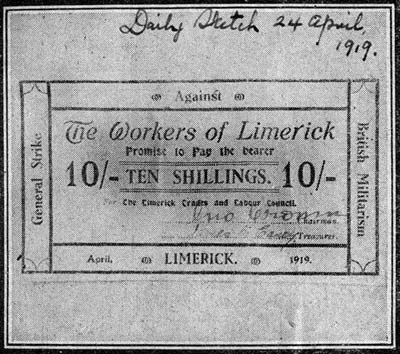
A Limerick Soviet Promissory note of a different design, illustrated in the Daily Sketch, 24 April 1919. Image source, RTE [17.]
As far as we know, the signatures are correct on this version.
Casey has signed himself as 'James M Casey', understood from observation of extant notes to be his non-standard signature, which we have seen on various non-issued instances of the notes. His signature on valid notes has always been observed as 'James Casey'.
The note design above may have been redesigned to make it clearer that The Workers of Limerick were Against British Militarism. In the image above, 'Against' is isolated in the top panel.
The Limerick Soviet happened as a result of a mixture of general post-World War 1 social upheaval and the gathering momentum towards the Irish War of Independence.
The aftermath of the 1916 Rising had removed most of the militant Nationalist leaders from circulation. This allowed the rise of the militant labour movement, sometimes in an unsure alliance with the new Sinn Féin movement. Also in the picture was the Irish Republican Army (IRA) which emerged in 1919 out of the Irish Volunteers, which had been formed in 1913 'to secure and maintain the rights and liberties common to the whole people of Ireland' as stated in the Manifesto of the Irish Volunteers.
With a shortage of troops for the war in Europe, the British Government decided to extend conscription to Ireland in April, 1918. Politicians, the Church and the labour movement, in the form of the ITGWU, all came together in their opposition to conscription. This resulted in a general strike in protest on 23 April 1918 which lead to the idea of conscription in Ireland being abandoned, a significant victory over the British Government [10].
At the end of World War 1, Europe was in turmoil. Germany and the Austro-Hungarian Empire had collapsed, taking the old order with them, against the background of the rise of Bolshevism. There was widespread social and economic revolution throughout the continent.
In the United Kingdom of Great Britain and Ireland there was similar unrest with regular strikes in major industrial cities in Britain. August 1918 to April 1919 saw general strikes in several locations in Ireland in a peaceful effort to win a better deal for workers. This was against a general background of insurrection in Ireland as the War of Independence commenced.
It was against this background that an incident occurred on 6 April 1919 in which Robert Byrne, a trade unionist and IRA man, court martialed and jailed in February on a gun possession charge, was rescued by the IRA from a prison hospital. It was a botched operation, during which a police constable, Martin O’Brien, was killed [Cahill 1990, p. 50]. Byrne also died later from his wounds. He had been a leader of the struggle for political status for IRA prisoners whilst in prison. Thousands of marchers attended his funeral on April 10.
On April 9, citing the death of the police constable as a reason, much of Limerick city and county was declared a Special Military Area under the provisions of the Defence of the Realm Act. These provisions were intended to flush out IRA men concealed in the midst of local populations. It enabled the military to issue exit and entry permits for the area and made the population subject to police inspections at any time. Tanks were used to secure the streets at entry points to the SMA. The restrictions were quite repressive and were resented by the population at large.
The Limerick Trades and Labour Council was an umbrella organisation of 35 trade unions. It’s president was John Cronin of the Amalgamated Society of Carpenters. At a meeting on Sunday April 13 1919, the LTLC called a general strike in Limerick, to protest at martial law and the fact that many workers had to have permits and pass through the military check points in order to go to and from work each day. The strike started on Monday 14 April 1919. 14,000 workers had joined the strike by that Monday evening.
The strike committee took over the administration of Limerick, a city with a population of 38,000. The distribution of food throughout the city was regulated and prices were strictly controlled to avoid shortages or profiteering. Certain shops were instructed to be open between 2 and 5 pm each day to supply foodstuffs to the population. The LTLC also published its own newspaper and issued its own currency. It quickly became known as the Limerick Soviet - a 'Soviet' being a self-governing committee - although the situation bore little in common with happenings in Russia [6].
Negotiations progressed throughout the duration of the strike. The British Army softened the regulations governing the issue of permits, by suggesting that employers be allowed to issue them, a move rejected in the first instance by the Soviet’s leaders. In the end, the strike was not supported by other unions outside of the Limerick area, most notably the big unions based in Britain.
The hope of its organisers that it might become a country-wide general strike, or that Limerick might be evacuated, were not realised, leaving the strikers few options but to accept a settlement. The LTLC decided to end the strike and on Friday 25 April most strikers resumed work, only those subject to permit inspections remaining out. The strike ended on Monday 28 April with all the strikers returning to work.
In the event, any IRA men who were within the SMA kept a low profile throughout the proceedings and it proved ineffective in its efforts to flush them out. On 5 May Military restrictions were officially ended.
The British Army commander in charge of the military area was a General Griffin, who handled the whole affair with cautious but firm diplomacy and sought to avoid any nasty incidents. On the whole, the affair was a generally peaceful one. The only significant confrontation was the eventual successful breach of the area by several hundred people on Easter Monday, 21 April 1919, following a protest the day before.
Although an open challenge to the British Government, the strike was not intended to be political, but was about the rights of workers to come and go to their place of work without repression.
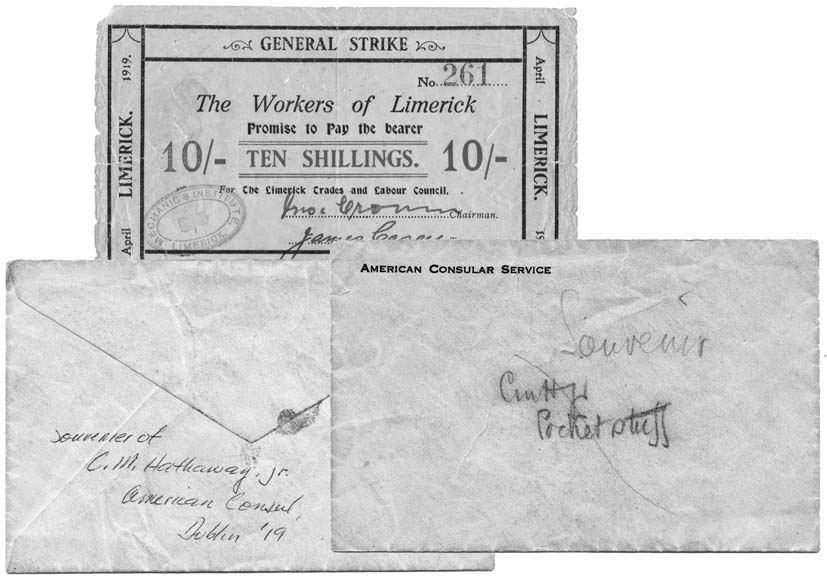
It is pictured with the American Consular Service envelope it was stored in. It shows that the Americans were keeping an eye on events in Ireland at the time. This note, along with the envelope it was kept in turned up in a collectibles shop in San Francisco, CA in 2003.
Below is the RTE documentary on the Limerick Soviet which briefly explains the background to the events [15].
Revised Version (2023)
Original [print] version (2015), published in Coin News as 'Banknotes of the Limerick Soviet, April 1919. A study of the notes and their signature varieties', November 2015, p76.
This page. Original [electronic] version (2015) www.irishpapermoney.com/forum/viewtopic.php?f=22&t=324 Numismatic Articles and Papers / Occasional Papers on Irish Paper Money
[Online all last accessed 10.12.23, unless otherwise indicated]
1. Cahill, L. (1990) 'Forgotten Revolution: Limerick Soviet 1919, A Threat to British Power in Ireland' ISBN 0-86278-194-9.
2. Cahill, L. (2019) 'Forgotten Revolution: The Limerick Soviet of April 1919'. Notes for an illustrated talk at the Granary Library, Limerick, 10th April 2019. https://www.limerickcity.ie/media/limerick soviet 21.pdf
3. KEMMY, J. (1976). 'The Limerick Soviet', Saothar, 2, 45–52. https://www.jstor.org/stable/23195163
4. KEMMY, J. (2019). A report on the Limerick Soviet, The General Strike – 1919, by Jim Kemmy, is reproduced on the Limerick city website: https://www.limerickcity.ie/media/Media,3944,en.pdf
5. Limerick Soviet also called 'The General Strike, 1919' Limerick City Library Archive https://www.limerickcity.ie/Library/LocalStudies/LocalStudiesFiles/L/LimerickSoviet/
6. Nielsen, R., (2012) Limerick Soviet blog post: https://whistlinginthewind.org/2012/10/06/1919-limerick-soviet/
7. O'Connor Lysaght, D. R., 'The Story of the Limerick Soviet', 1979. https://libcom.org/files/The%20story%20of%20the%20Limerick%20soviet.pdf
8. Smyth P. (2019). 'When Limerick workers seized the city – for two weeks'. The Irish Times, Jan 21, 2019. https://www.irishtimes.com/culture/heritage/when-limerick-workers-seized-the-city-for-two-weeks-1.3742342
9. Young, D. 'The Limerick Soviet and its Notes', Coin and Medal News, February 1985, pp. 54-57.
10. https://www.historyireland.com/podcast/the-cause-of-labour-the-1918-general-strike-against-conscription/
11. Toronto World, 22 April 1919. Date of the news is stated as 'Limerick 21 April'. https://news.google.com/newspapers?nid=hqOjcs7Dif8C&dat=19190422&printsec=frontpage&hl=en
12. South Bend News-Times, Indiana, 22 April 1919, p. 3. This report is very similar to that in The Toronto World, except that the date of the news is stated as 'Limerick 22 April'. https://newspapers.library.in.gov/?a=d&d=SBNT19190422.1.3&e= [DEAD LINK Last accessed successfully 12.09.2022]
13. The National Library in Dublin has a section about the 1916 Rising. https://www.nli.ie/1916/
14. ILPTUC - Irish Labour Party and Trade Union Congress, 25th Annual Report 1919, P. 56. https://centenaries-ituc.nationalarchives.ie/wp-content/uploads/2014/10/25th-annual-report-1919.pdf
15. The RTE documentary program on this page about the Limerick Soviet, first screened on 23 June 1974, was on the RTE website - it has been removed. It might be made available again at its original url: https://www.rte.ie/radio/doconone/2012/0703/647122-documentary-podcast-limerick-soviet-workers/ - It remains on YouTube: https://www.youtube.com/watch?v=js0FR8GkBEo.
16. Noonans Mayfair, Auction catalogue, Banknotes 31 May 2023.
17. https://www.rte.ie/centuryireland/index.php/articles/limerick-people-locked-out-of-city-after-attending-hurling-match
Further Reading
1. Cahill, L. (2019) 'Forgotten Revolution [The Centenary Edition] The Limerick Soviet 1919' ISBN 10: 1912328410, ISBN 13: 9781912328413.
2. Prenderville, C. 'The Limerick Soviet of 1919 is part of a hidden history of Ireland', The Journal, April 2019, marking the centenery of the Limerick Soviet.
3. Smith, P. 'When Limerick workers seized the city for two weeks', The Irish Times, January 2019.
4. Lonergan, J. 'The Limerick Soviet 1919', History Ireland, vol. 30, no. 5 (September/October 2022), pp. 40-43.
Special Sections and Articles
The Transition of Irish Currency, Irish banknotes 1918–1928
The Partition of Irish Currency, Irish banknotes 1928–1930
Banknote Design Evolution 1824 to 1916
Irish Three Pound Notes
Contemporary Forgeries of Early Irish Banknotes, ca1800-1930
Limerick Soviet Notes
Irish World War 2 Banknote Issues
A Series Irish Ten Shilling Notes
B Series 100 Pound Note
Low Number Irish Banknotes
Irish Joint Stock Banks of Note Issue from 1783
Irish Legal Tender Note Specimens
Ploughman Scan Survey (PSS)
![]()
![]()